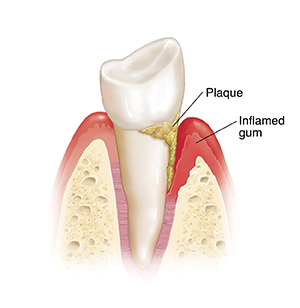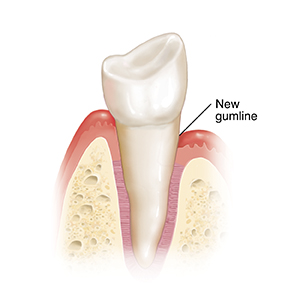Periodontal Disease: Pocket Reduction Surgery
Periodontal disease can cause pockets to form between the tooth and gum. These pockets can gather plaque and need treatment. If nonsurgical treatments can’t reduce pocket depth, surgery may be needed. Surgery on gum and bone can reduce pocket depth and save a tooth or teeth. It allows the periodontist to remove tartar deep below the gumline. In some cases, pocket reduction surgery is combined with regenerative procedures. These are methods that stimulate new bone growth.
Reshaping gum and bone
Pocket reduction begins with flap surgery. The gum is separated from the tooth and later reattached in a new position. In most cases, osseous surgery is also done. This involves reshaping and smoothing the bone. After treatment is complete, the gumline will most likely be lower. This leaves more of the tooth exposed. If the root is exposed, ongoing treatment with fluoride or another material may be needed to reduce sensitivity.
-
Before surgery. A deep pocket allows plaque and tartar to collect far below the gumline. Inflammation and infection have destroyed some supporting bone.
-
Opening the gum. The gum is first lifted and rolled back, creating a gum flap. Tartar and bacteria are then removed from the root. The surgeon also removes diseased gum tissue.
-
Shaping the bone. If needed, the bone is smoothed and reshaped. This reduces irregular areas where bacteria grow.
-
Helping tissues heal. A substance may be applied to the root to help the ligaments and gum reattach. Tools may be used to seal off the area and reduce bleeding.
-
Closing up. The gum flap is sewn shut in a position that reduces pocket depth. A dressing may be used to protect the area. This dressing is a bit like clay or putty. If used, it remains in place until removed by your periodontist at a follow-up visit.
-
After the gum heals. Once the gum is healed, the stitches dissolve or are removed. Your periodontist also removes the dressing. The pocket is shallower. With a lower gumline, it is likely that more of the tooth will be visible. Good oral hygiene and regular dental visits are needed to maintain the health of the gum tissue.
 |
| Before surgery. |
 |
| After the gum heals. |
Online Medical Reviewer:
Daphne Pierce-Smith RN MSN
Online Medical Reviewer:
Mahammad Juber Medical Researcher
Online Medical Reviewer:
Raymond Turley Jr PA-C
Date Last Reviewed:
2/1/2025
© 2000-2025 The StayWell Company, LLC. All rights reserved. This information is not intended as a substitute for professional medical care. Always follow your healthcare professional's instructions.